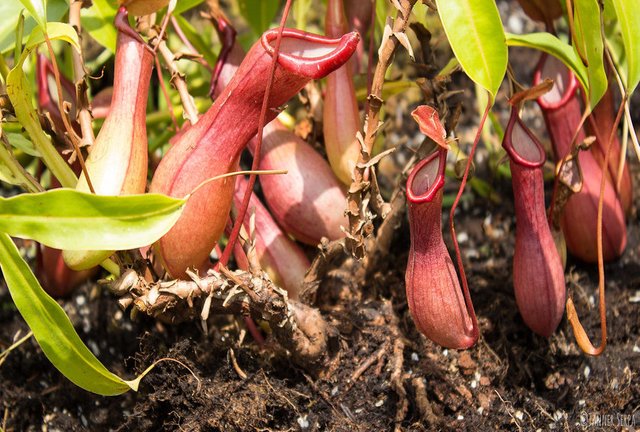The carnivorous plant encyclopedia - Chapter 2: plants for the advanced: Nepenthes (Tropical pitcher) - the ghoulish exotic
Nepenthes (Tropical pitcher plant):
Habitat:
Among all carnivorous plant species the Nepenthes have the largest specimens. Their main distribution area is in South East Asia, where the greatest diversity of the Nepenthes species is endemic to Borneo, Sumatra and the Philippines. Growing within altitude ranges of 0-3,500 meters these plants develop vines by means of which they like to anchor into and twine themselves up high trees. Nepenthes are dioecious, which means there are males and females producing unisexual flowers on separate plants. The male ones are the pollen-producing flowers, while the female ones are the seed-producing flowers. The so-called "Golden Age of Nepenthes" dates back to the late 19th century, when especially aristocrats and wealthy citizens cultivated this plant because of its rather pretentious and flamboyant appearance.
Source |  Source |
Cultivation:
Most tropical pitcher plants commercially available in garden centers are very resilient hybrids that are relatively temperature tolerant, coping well with a temperature range from 15-30°C. Since Nepenthes are endemic to tropical climates they feel most comfortable in environments with a humidity above 60%. Therefore, if cultivated indoors, preferrably in a terrarium that allows the plant to grow unimpededly, it should always be taken care of that there is plenty of humidity the plants can draw on. Otherwise they won't develop their pitchers. Also noteworthy is that the glaring red coloration results from ample sunlight. Among all carnivorous plant species the Nepenthes' demand for sunlight is rather average; they enjoy sunbathing but also like to cool down, especially during the colder seasons. As is the case with all carnivorous plants, they shun lime; rainwater or distilled water pose the best watering solutions. The pitcher starts as a small bud developing a leaf rosette, and from here will slowely expand into a globe or tube-shaped trap.
Trap mechanism:
The Nepenthes' pitcher can have a capacity of up to two liters, whereby the leaf lid (=operculum) is serving as a pretty firm umbrella that protects against the rain. The digestive juices within the pitcher are very acidic so that the digestion of microbes can be complete after two days already. Very similar to the Sarracenia the Nepenthes has a passive pitfall trap mechanism that lures prey into the trap by way of colorplay, scent emission and nectar secretion. Depending on the environmental degree of precipitation and humidity, the pitcher’s lip (=peristome) around the entrance can be particularly pronounced, making for extra slippy footing. The shape of the pitcher can vary hugely between each plant and mainly adjusts to the type of prey in its environment. After about three months the pitcher usually starts decaying. Furthermore, the pitchers of young Nepenthes look completely different compared to mature ones. It is recorded that the largest subspecies, the Nepenthes rafflesiana, occasionally even catches vertebrates such as rats and lizards.
Much Love and Light,
Alex
Literature inspiration: Kosmos Garten: Fleischfressende Pflanzen

Thank you so much for participating in the Partiko Delegation Plan Round 1! We really appreciate your support! As part of the delegation benefits, we just gave you a 3.00% upvote! Together, let’s change the world!